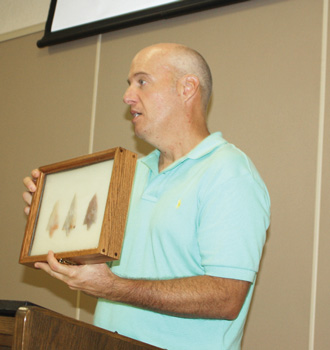Florida natives strong, friendly, conquered

tOM VAUGHT | SUN
Scott Chandler brought visual aids to his presentation
on the first residents of Florida, the Native Americans
who were discovered by explorers.
HOLMES BEACH – When Christopher Columbus arrived in America, his first meetings with native tribes were usually cautious, but friendly, according to amateur archeologist Scott Chandler, who spoke at the Island Branch Library recently, as part of the Lifelong Learning Academy’s lecture series. Speaking to more than 20 attendees in the Walker-Swift meeting room, Chandler read excerpts from writings of explorers about the encounters with the natives who were here.
Columbus wrote that the Arawak Indians had a very good understanding of their environment.
“In the world, there is no finer people,” the explorer wrote. “They helped pull our ship off the shoals when the tide went down.”
Chandler, who has been researching the natives, or Indians as we call them, said even the Carribes, the tribe that gave the Caribbean its name, were peaceful when they first encountered Europeans. The Carribes were later found to be a tribe of ferocious fighters.
Chandler said the natives were more polite and disciplined than the explorers expected.
“The young called their parents ‘the honored ones,’” Chandler said, “also they did not look at others when they were talking to someone because they felt it was not polite.”
Chandler said explorers were often the ones at a disadvantage.
“In 1528, Cabeza de Vaca landed in Tampa Bay, which was called the Bay of the Cross, and explored around the Gulf,” he said. “He encountered a number of tribes and documented his encounters, but while exploring the region, he was shipwrecked and one of four survivors to return.”
Chandler said de Vaca described the natives as fierce warriors with unusual strength who could put an arrow deep into what they hit.
“They appeared to be giants to him,” Chandler said. “He said they had bows as thick as an arm and up to six feet long.”
Explorer Ponce de Leon was known for searching for the fountain of youth. Chandler said the condition of the Indians he first encountered might have inspired his search.
“He ran into several old Indians, which he said appeared to be as old as 250 years,” Chandler said. “That might have given him the idea there was a fountain of youth.”
Chandler said the Arawak Indians were very sympathetic with the explorers.
“When Columbus got one of his ships stuck, the Arawaks wept,” he said. “They wept a lot, and if a family lost a child, they might weep three times a day for up to a year.”
Chandler said the tribes all had different languages and different values.
“Some Indians would rather kill their children rather than let them marry their enemies,” he said.
The Indians were often small because they ate very little.
“They were usually very hungry and would eat bugs, dirt, wood, even deer excrement,” he said. “Some tribe members could run all day following a deer,” Chandler said. “They often caught deer by following them until the deer got tired.”
One tribe that settled on South Padre Island was described as very happy people. Chandler said they danced, made merriment and loved prickly pear, a cactus that was a favorite of people in Mexico and South America, often eating it for weeks.
They also had horrible mosquitoes and would burn wet wood to produce smoke that would drive the pesky insects away.
Chandler said the natives of America were diverse and able to live off the land. He said many of them were killed by diseases from the Europeans, while others fell victim to the explorers themselves, who often took them as slaves.

